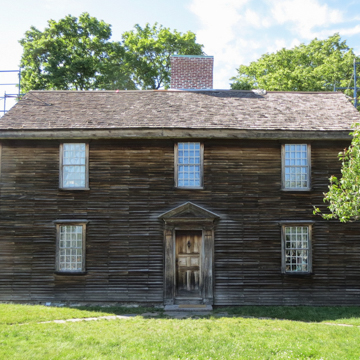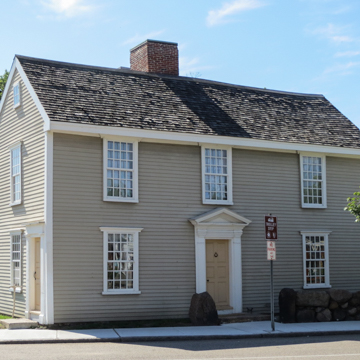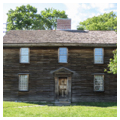The two oldest surviving American presidential birthplaces are typical clapboard vernacular houses. Their construction dates were recently identified by dendrochronology. Each is a double-cell, lobby-entrance house with central chimney and added lean-to. John Adams Birthplace was restored in 1897 with the east rooms representing the supposed seventeenth-century origins of the house. In fact, the chamfered summer beam in the east room is one of the several reused timbers dated to 1678 that were incorporated into the building of 1722, possibly from an earlier house on the site. The west rooms are finished with eighteenth-century woodwork. A striking feature of John Adams Birthplace is the presence of reused rafters that originally supported clasped purlins, a framing practice common in England but rare among surviving buildings in the United States. John Quincy Adams Birthplace, built in 1717, includes a brick dated June 1716 in a fireplace. Georgian woodwork survives in the major rooms, where exposed timbers are finished with beaded edges that (atypically) end in delicate coved stops.
John Adams was born in 1735 at 133 Franklin Street, traditionally in the east chamber of the saltbox. In 1744 the father also acquired 141 Franklin Street and may have added pilastered, pedimented door surrounds to both houses. Upon the senior Adams's death in 1761, a brother inherited 141 Franklin, where John Quincy Adams was born in 1767. John Adams reunited the two houses in 1774, although he and Abigail often occupied homes in Boston until the Revolution. Both properties were sold to John Quincy Adams in 1803. He summered in his old birthplace until 1806; a brother, Thomas Boylston Adams, occupied the older house from 1810 to about 1820. They were rented thereafter, often to workers in the stone quarries behind the house. A second rear chimneystack was added in the older house by midcentury.
The houses remained in the Adams family into the twentieth century. Architect Robert Swain Peabody listed both houses in his 1877 study of colonial architecture, but preservation efforts began only after 1892, when the Adams family was criticized for indifference. A new Quincy Historical Society leased 141 Franklin Street, and the organization began restoration in 1896. The Daughters of the Revolution rented John Adams Birthplace and restored it the next year. Both homes were sold to the city in 1940 to foster “civic virtue and patriotism” and acquired by the National Park Service in 1978.


















